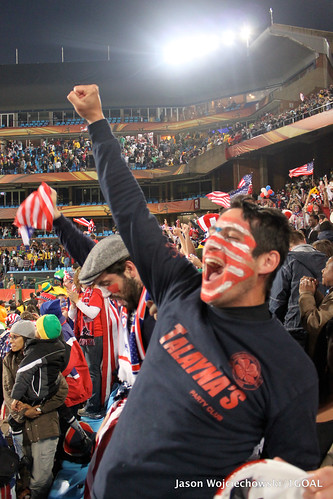 |
| USA v Algeria, 2010 World Cup by jasonwhat |
In planning the construction of new stadiums, it is evident there was little consultation with local sports organisations who would in future be potential clients of the new facilities. Rugby teams have avoided moving out of their smaller venues to these larger stadiums for a variety of predictable economic reasons, while cricket teams cannot even begin to contemplate moving, as in a literally monumental demonstration of ineptitude, the new stadiums were designed and built so that the dimensions of a cricket field will not fit within the new stadium's playing areas. Cricket and Rugby are both more commercially successful in South Africa than soccer; a sport whose local teams count spectators in the hundreds, rather than the tens-of-thousands required to fill the new and refurbished venues. Many in South Africa are wondering how it is possible that these stadiums sit empty most nights, when $1.3 billion was spent alone on upgrading and building them.
The Cape Town Stadium was built at Green Point on the site of an older much smaller stadium, after much controversy. Green Point is a middle-class suburb, whose cleanliness and relative modernity would make it more attractive to tourists attending the World Cup; however, many Green-Point residents opposed the building, and a wider group of locals wondered aloud why a soccer stadium would not be built much closer to the poorer neighborhoods which house Cape Town's actual soccer fans. The SI article, printed November 22, 2010, reveals that only 3 events have been held at the stadium since the close of the World Cup. Furthermore, it states that "the company due to take over the stadium's 30-year lease on Nov. 1 pulled out of the deal, forcing the city to cover maintenance costs of around $6 million a year."
The reality of empty stadiums unable to cover the costs of their own maintenance is not exclusive to Cape Town. More than one stadium was built in rural areas whose populations will never support attendance of multiple thousands for regular domestic league sports events. South Africans, half of whom according to the UK paper The Independent survive on an average of 130 pounds per month, are today largely unaffected by their government's spending spree on the world's biggest party, in spite of how jubilant they may have been portrayed by international media during the event. The workers who built the stadiums, who were typically paid 19 pounds per week, must be wondering where the $1.3billion in stadium construction and refurbishment actually went. While the South African townships and taxpayers are left with the construction debts and maintenance costs of the stadiums, FIFA had bagged $1.6billion from advertising and other sources before the tournament even began, profits which the South African government treasury was excluded from sharing in. Local activists have accused FIFA, South African officials, and contractors of mafia style collusion in bullying opponents and municipal representatives toward their ends, with the murder of whistleblower Jimmy Mohlala being a prime example; a web search of this name reveals innumerable theories as to the sponsors of his assassination.
Politicians and FIFA representatives promised an event which would help to unify Africa and the world, which would boost Africa's economy and help to modernize and make South Africa a destination of international interest. Instead the story of the logistics of the 2010 World Cup has, for many, reinforced the image of African leaders as corrupt and detached from their people, as well as the stereotype that rich white Europeans have no interest in Africa beyond economic exploitation. With Russia and Qatar, two nations badly lacking in infrastructure and sports facilities, recently named as hosts for upcoming World Cups amid allegations of bribery and corrupt vote trading, the question remains: Is the World Cup foremost a celebration of the world's most popular and transcending sport? Or does its existence depend on the ability of certain elites to enrich themselves cynically at the expense of fans who truly abide by the ideals of harmony, unity and fair-play?
Google search for Jimmy Mohlala:
http://www.google.ca/#hl=en&expIds=17259,27757&xhr=t&q=jimmy+mohlala&cp=9&pf=p&sclient=psy&aq=0&aqi=&aql=&oq=jimmy+moh&gs_rfai=&pbx=1&fp=2c0b2ef780091f9e
Sports Illustrated World Cup's Empty Legacy article:
http://sportsillustrated.cnn.com/vault/article/magazine/MAG1177591/index.htm
Video:
http://www.youtube.com/watch?v=ibAthe-_5fI
More links:
http://www.independent.co.uk/news/world/africa/south-africas-world-cup-venues-are-white-elephants-1840958.html
http://www.nzherald.co.nz/sport/news/article.cfm?c_id=4&objectid=10650784
http://special.registerguard.com/csp/cms/sites/web/sports/25197365-41/rugby-south-cup-stadiums-africa.csp
http://www.guardian.co.uk/football/2010/jun/13/world-cup-stadiums-empty-seats
http://fourfourtwo.com/news/worldcup2010/40888/default.aspx
http://2010.mg.co.za/article/2010-05-14-no-one-wants-to-air-2010-documentary